Bala is a market town situated in the historic county of Merionethshire, at the north end of Bala Lake. It is an ancient settlement, which contains the ruins of a Roman Fort and a Norman Castle, but is most famous for it’s picturesque setting, surrounded by mountains and rovers, and it’s lake, Llyn Tegid. The men, and two women, of the area who fell during both World Wars, are commemorated on the war memorial which is located in the High Street.
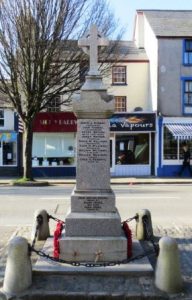
The Great War, 1914-1918
David Morris Davies, Sergeant, 2160, Royal Welsh Fusiliers. David was the son of John and Kate Davies, of 52, Mount Street, Bala. He worked as a Tailor prior to the war, and was a former footballer as well as a member of the Territorial Army, after having enlisted at Bala into the 7th Battalion, Royal Welsh Fusiliers several years prior to the war. The battalion was a Territorial unit, which mobilised for war at Newtown in August 1914, as part of North Wales Brigade, Welsh Division and moved to Conway until the end of the month, before moving to Northampton. In December the Division moved to Cambridge and then in May 1915 to Bedford, where the Division was numbered and the formation became 158 Brigade, 53rd (Welsh) Division. On 19 July 1915 the entire Division sailed from Devonport for Imbros and on 9 August 1915 landed at Suvla Bay and saw heavy casualties over the coming days. The Division was eventually evacuated from Gallipoli in December 1915, moving to Egypt to join the EEF, and helped guard the Suez Canal before taking part in operations to drive the Turks out of the Sinai. David survived the rigours of Gallipoli, but took ill and died of heart disease at the Moascar Hospital, Ismailia, on 23 July 1916, aged 36. He is buried in Ismailia War Memorial Cemetery, Egypt.
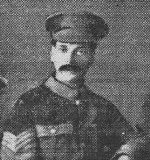
John William Davies, Private, 61072, Royal Welsh Fusiliers. John was the son of John and Jane Davies, of Rhosygwaliau, Bala. He married Catherine Hughes, of Minafon, Llandderfel, early in 1917. John had enlisted into the Royal Welsh Fusiliers at Dolgellau, and was posted out to France in the spring of 1917, joining the 2nd Battalion, Royal Welsh Fusiliers, which was attached to 19 Brigade, 33rd Division. John would have seen his first major action when the Division took part in the Battle of the Scarpe and then alongside the Australians at Bullecourt, before the Division headed to Ypres. The Division took part in the Battle of the Menin Road and launched a costly assault on Polygon Wood. The Division wintered in the Ypres Salient, carrying out the normal system of rotation of units in the trenches over the coming months. On 20 January 1918, the 2nd RWF was holding the front line when an aircraft circled above them. Shortly afterwards an artillery barrage came down upon their positions, which killed just one man, John. He was 26 years old and is buried in Oxford Road Cemetery, Belgium. His brother, Thomas Hugh Davies, also fell.
Rowland Hugh Davies, Private, 19092, King’s Shropshire Light Infantry. Rowland was the son of Lewis and Margaret Davies, of 16, Castle Street, Bala. He worked as a farm labourer at Blaenycwm, Llandderfel prior to the war. Rowland enlisted at Bala into the King’s Shropshire Light Infantry, and upon completing his training was posted to France early in 1916, joining the 1st Battalion, King’s Shropshire Light Infantry, which was attached to 16 Brigade, 6th Division. He probably joined up with the battalion at Ypres, in positions along the Canal Bank at Boesinghe. On 25 February the battalion took over positions at Railway Wood, spending several weeks there before moving to Calais to rest and then spent some time training before returning to the Canal Bank sector on 17 April. On the night of 21/22 April 1916 the battalion carried out a successful raid against the German strongpoint in the Mortjelde Estaminet. Rowland was killed in action during the raid, on the morning of 22 April 1916, aged 19. He has no known grave and is commemorated on the Ypres (Menin Gate) Memorial, Belgium.
Thomas Hugh Davies, Private, 38464, Gloucestershire Regiment. Thomas was the son of John and Jane Davies, of Rhosygwaliau, Bala. He enlisted into the South Wales Borderers at Wrexham, and after completing his training was posted to France in 1916, joining the 8th Battalion, Gloucestershire Regiment. The battalion was attached to 57 Brigade, 19th (Western) Division, and had suffered heavy casualties when the Division took part in the Battle of Messines Ridge in June 1917. Thomas joined the battalion among a number of reinforcements following the battle. The battalion spent much of August and the first fortnight of September behind the lines, resting and training, and Thomas probably arrived among a batch of 144 reinforcements on 12 September. On 18 September the battalion moved back towards the front at Klein Zillebeke and at 05.40 on 20 September 1917 launched an assault during the opening of the Battle of the Menin Road. Thomas was killed in action here, during his first action that day. The 19-year-old has no known grave and is commemorated on the Tyne Cot Memorial, Belgium. His brother, John William Davies, also fell.
Guy Dickins, Captain, King’s Royal Rifle Corps. Guy was born on 23 October 1881, the son of Albert Lungley Dickins and Margaret Jane Dickins (nee Jones), of Hopefield, Manchester. He was baptised at Llanycil Church, Bala on 6 August 1882. He was educated at St. John’s, Oxford, and was a highly regarded archaeologist, specialising in Ancient Greece, who had excavated at Sparta and had written several books on the subject. Guy married Mary Hamilton, of Riverside, Callander, Perthshire, in 1908. Following the outbreak of war, Guy sought a commission into the King’s Royal Rifle Corps, and was posted to their 13th Battalion. The battalion had formed at Winchester in October 1914, and in April 1915 moved to Windmill Hill, Salisbury Plain, joining 111 Brigade, 37th Division. Guy landed in France with the battalion on 31 July 1915 and the Division concentrated near St Omer by 2 August 1915 before moving to positions on the Somme. The Division took part in the Attack on the Gommecourt Salient, during the first phase of the Battle of the Somme. Guy’s battalion was in reserve at Berles during the opening two days of the battle and on 3 July marched to Pas. The battalion did not march into the battle area until 7 July, when it reached Becourt Wood and two days later relieved a battalion of the 19th Division in the 3rd Line. On 11 July the 13th KRRC moved into the 2nd Line and on the following morning took over a section of front line. Soon after taking over the front, the battalion came under shell fire. One of Guy’s men was badly wounded, and whilst Guy was tending him, he was wounded himself by shrapnel. Guy was evacuated away from the front, but died of his wounds in Hospital in Amiens on 17 July 1916, aged 34. He is buried in St. Pierre Cemetery, Amiens, France.
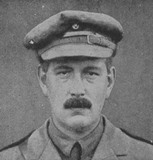
William Robert Dowle, Private, M/338389, Royal Army Service Corps. William was the son of William Robert and Mary Ann Dowle, of Dover. He married Ethel Maud Holmans, of Dover, in 1912, and the couple soon moved to Idris View, Mount Street, Bala, where William had gained work as a Chauffeur and their son Robert was born on 4 March 1914. William enlisted into the Army Service Corps after the outbreak of war and was posted to the 881st Motor Transport Company. William survived the war but fell ill and died of influenza in Serbia on 14 November 1918, aged 30. He is buried in Chela Kula Military Cemetery, Nis, Serbia.
Edward Evan Edwards, Sergeant, 4838, Royal Welsh Fusiliers. Edward was the son of Richard and Jane Edwards, of Tecid Street, Bala. He had trained as a joiner and was a member of the local Militia prior to enlisting into the Royal Welsh Fusiliers on 1 November 1895, and had served around the Empire with the 1st and the 2nd Battalions of the Royal Welsh Fusiliers prior to the war. He had left the army and was a reservist when war broke out, so re-enlisted at Wrexham on 6 August 1914, and was posted to the 2nd Battalion, Royal Welsh Fusiliers. The battalion landed at Rouen on 11 August 1914, to work on Lines of Communication. The battalion then moved to Valenciennes on 22 August, joining 19 Brigade, an independent unit, and then took part in the retreat from Mons to the Marne. After the BEF moved to the Ypres Salient, 19 Brigade became attached to the 6th Division on 12 October and saw heavy fighting during the First Battle of Ypres. The Division remained in the Ypres Salient over the winter. Edward became ill during the spring of 1915, and was evacuated to No 12 General Hospital at Rouen, where he died of pneumonia on 18 May 1915, aged 38. He is buried in St. Sever Cemetery, Rouen, France.
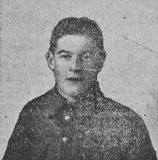
Edward William Edwards, Private, 290521, Royal Welsh Fusiliers. Edward was the son of Watkin Edwards and Elizabeth Edwards, of 18, Plasey Street, Bala. He enlisted into the 7th Battalion, Royal Welsh Fusiliers at Bala on 20 April 1914 and took part in his first, and only, Annual Territorial Camp that summer. The battalion was a Territorial unit, which mobilised for war at Newtown in August 1914, as part of North Wales Brigade, Welsh Division and moved to Conway until the end of the month, before moving to Northampton. In December the Division moved to Cambridge and then in May 1915 to Bedford, where the Division was numbered and the formation became 158 Brigade, 53rd (Welsh) Division. Edward remained in Northampton with the 68th (2nd Welsh) Division when the 53rd Division embarked for Gallipoli. He married Harriet Alice Tarry, of Northampton, early in 1916 and their son Lawrence was born on 3 July 1916. Edward suffered several spells in hospital with various ailments during that year, contracting diphtheria and scabies. Edward was by now station with the 2/7th Battalion, Royal Welsh Fusiliers at Wrentham. On 23 January 1917 he was lying in bed in his hut when he was struck in the hip by a stray bullet which had been accidentally fired by a sentry. He was taken to the Snowden Hill Military Hospital at Wickham Market, but died just before reaching the Hospital. Edward was just 20 years old, and his remains were conveyed home for burial in St. Beuno Churchyard, Llanycil.
John William Edwards, Private, 21160, Royal Welsh Fusiliers. John was the son of Cadwalader and Jane Ann Edwards, of Tynant, Cwmtirmynach, Bala. He worked as a farm labourer prior to the war. John enlisted at Bala into the 14th Battalion, Royal Welsh Fusiliers soon after the declaration of war. The battalion was raised at Llandudno by the Welsh National Executive Committee, joining 128 Brigade, 43rd (Welsh) Division and trained in North Wales before moving to Winchester in the summer of 1915, where the formation became renumbered 113 Brigade, 38th (Welsh) Division. The Division moved to France on 2 December 1915 and moved to the Nursery Sector near Fleurbaix for trench initiation alongside the Guards Division. The Division then held a sector of the line near Cuinchy before marching south to the Somme sector in June 1916 to take part in the assault on Mametz Wood. The first attack on the wood was launched on a two-battalion front on 7 July, but failed, and the Divisional Commander, Sir Ivor Philipps, was replaced before the Division attacked again on a two Brigade front on 10 July 1916. John was badly wounded during the assault on 10 July and was evacuated to the Casualty Clearing Station at Heilly, where he died of his wounds the following day, 11 July 1916, aged 20. He is buried in Heilly Station Cemetery, Mericourt-L’abbe, France.
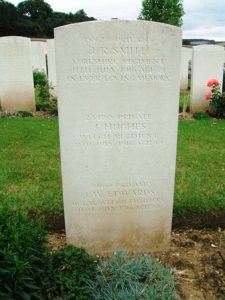
John Samuel Ellis, Private, 21166, Royal Welsh Fusiliers. John was the son of William and Hannah Ellis, of Bala. He married Susannah Jane Lloyd in 1899, and the couple lived at 3, Arenig Court, Bala. John was a former soldier, and worked for the Great Western Railway prior to the war. When war was declared, he volunteered to serve again, and enlisted at Bala into the 14th Battalion, Royal Welsh Fusiliers. The battalion was raised at Llandudno by the Welsh National Executive Committee, joining 128 Brigade, 43rd (Welsh) Division and trained in North Wales before moving to Winchester in the summer of 1915, where the formation became renumbered 113 Brigade, 38th (Welsh) Division. The Division moved to France on 2 December 1915 and moved to the Nursery Sector near Fleurbaix for trench initiation alongside the Guards Division. The Division then held a sector of the line near Cuinchy before marching south to the Somme sector in June 1916 to take part in the assault on Mametz Wood. John was killed in action whilst his battalion was moving into positions at Dantzig Alley on 6 July 1916. The 40-year-old has no known grave and is commemorated on the Thiepval Memorial, France. Shortly afterwards, before receiving news of her husband’s death, his wife Susannah received a letter from their eldest son, Edward Jones Ellis, also serving in France, stating that he had met his father at the front and hoped he was well.
William Henry Ellis, Private, 36910, Royal Welsh Fusiliers. William was of William Thomas Ellis and Margaret Ellis, of 2, Arenig View, Bala. He enlisted at Bala into the Royal Welsh Fusiliers on 15 November 1915 and after completing his training embarked aboard the SS Copenhagen at Southampton for France on 26 April 1916. William was posted to No 2 Infantry Base Depot at Rouen, and from there was posted to the 2nd Battalion, Royal Welsh Fusiliers on 7 May 1916. The battalion was attached to 19 Brigade, 33rd Division, and William would have seen his first major action during the Divisions assault on High Wood, during the Battle of the Somme. He was badly wounded at High Wood on 20 July and eventually invalided to England on 2 August. William recovered from his wounds, but they had taken a toll on his fitness, and after almost a year back in England, William was discharged from the army at Shrewsbury on 13 July 1917 and joined his widowed mother, who by then was living at Birkenhead. He then became ill and died of tuberculosis at Birkenhead on 16 December 1918, aged 29. His remains were brought home to Bala for burial in St. Beuno’s Churchyard, Llanycil on 21 December 1918.
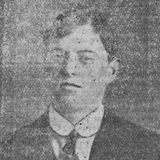
William Owen Ellis, Private, 39768, Border Regiment. William was born on 12 September 1885, the son of Owen and Mary Ellis, of 9, Croan Street, Bala. He was a porter for the Great Western Railway prior to marrying Jane Morris at Bala in 1910, and at some time prior to the war the couple moved to 22, Bronllwyn Road, Gelli, Rhondda. William enlisted at Pentre into the Welsh Regiment, and upon being posted to France, was transferred to the 5th Battalion, Border Regiment. The battalion was attached to 151 Brigade, 50th (Northumbrian) Division, before becoming the Pioneer Battalion to the 66th (East Lancs) Division on 12 February 1918, following the re-organisation of the British Army on the Western Front. The Division then moved south to the Somme, and on 21 March 1918 was hit by the German Spring Offensive, seeing heavy fighting as it withdrew over the coming days. After suffering very heavy casualties during the battle, the Division was first reduced to a training cadre and then reformed and reconstituted, before returning to action during the great advance, which was launched on 21 August 1918. William was killed in action during the advance, on 29 September 1918, aged 33. He is buried in Bellicourt British Cemetery, France.
John Evans, Private, 23330, Royal Welsh Fusiliers. John was the son of Edward and Margaret Evans, of Bridge Street, Cynwyd. He worked at Meini Hirion Farm, Bala prior to enlisting at Bala into the 16th Battalion, Royal Welsh Fusiliers soon after the outbreak of war. The battalion was raised at Llandudno by the Welsh National Executive Committee from a cadre from the 13th Battalion, joining 128 Brigade, 43rd (Welsh) Division and trained in North Wales before moving to Winchester in the summer of 1915, where the formation became renumbered 113 Brigade, 38th (Welsh) Division. The Division moved to France on 2 December 1915 and moved to the Nursery Sector near Fleurbaix for trench initiation alongside the Guards Division. The Division then held a sector of the line near Cuinchy before marching south to the Somme sector in June 1916 to take part in the assault on Mametz Wood. The first attack on the wood was launched on a two-battalion front on 7 July, but failed, and the Divisional Commander, Sir Ivor Philipps, was replaced before the Division attacked again on a two Brigade front on 10 July 1916. John was killed in action during the second day of fighting within the wood, on 11 July 1916, aged 22. He has no known grave and is commemorated on the Thiepval Memorial, France.
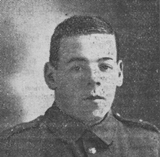
Joseph Henry Evans, Private, 26421, Royal Welsh Fusiliers. Joseph was the son of Robert Meredyth and Catherine Evans, of Castle Street, Bala. He worked as a Groom prior to the war. Joseph enlisted at Bala into the Royal Welsh Fusiliers on 12 August 1915, and was posted to Llandudno, joining the 17th Battalion, Royal Welsh Fusiliers. The battalion was raised at Llandudno, joining 128 Brigade, 43rd (Welsh) Division and trained in North Wales before moving to Winchester in the summer of 1915, where the formation became renumbered 113 Brigade, 38th (Welsh) Division. The Division moved to France on 2 December 1915 and moved to the Nursery Sector near Fleurbaix for trench initiation alongside the Guards Division. The Division then held a sector of the line near Cuinchy before marching south to the Somme sector in June 1916 to take part in the assault on Mametz Wood. Following its successful clearing of the wood, the battered Division was moved to positions at Hébuterne before being allocated to the Canal Bank sector of the line, north of Ypres. The Division held this line for almost a year prior to the launching of the Third Battle of Ypres on 31 July 1917. During its time here, the various battalions within the Division undertook a number of trench raids, and gained a good reputation for their work in strengthening and extending the trench lines, whilst undertaking the basic routines of day to day trench warfare. On one such day, 27 May 1917, Joseph was in the line with his battalion when it came under shell-fire, and one shell crashed into a group of men, killing Joseph and several others. Joseph was 38 years old when he was killed that day and is buried in Vlamertinghe Military Cemetery, France.
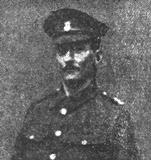
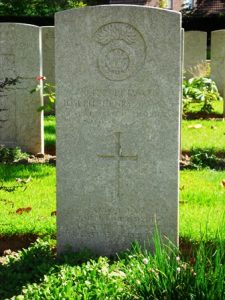
Owen Richard Evans, Private, DM2/171280, Royal Army Service Corps. Owen was the son of Elizabeth Evans, of Minafon, High Street, Bala. He was a bootmaker prior to the war, and married Sarah Catherine Williams, of 27, Devonshire Place, Chester, in 1915. Owen brought his wife back to Bala to live at 11, Cambrian Terrace, but soon afterwards enlisted into the Army Service Corps. He was posted to France, joining the 621st Motor Transport Company, Army Service Corps. Owen was not in France long when he took ill, and was found to be suffering from stomach cancer. He returned home, and was sent to Dolgellau Auxiliary Hospital, where he died of his cancer on 2 August 1917, aged 28. He was buried with full military honours in St. Mor’s Churchyard, Llanfor on 6 August.
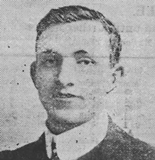
Robert John Evans, Private, 21290, Royal Welsh Fusiliers. Robert was the son of Edward and Ellen Evans, of Cefnrhos, Llanuwchllyn. He was a farm labourer at Gefnymeiroh prior to the war. Robert enlisted at Bala into the 14th Battalion, Royal Welsh Fusiliers soon after the outbreak of war. The battalion was raised at Llandudno by the Welsh National Executive Committee, joining 128 Brigade, 43rd (Welsh) Division and trained in North Wales before moving to Winchester in the summer of 1915, where the formation became renumbered 113 Brigade, 38th (Welsh) Division. The Division moved to France on 2 December 1915 and moved to the Nursery Sector near Fleurbaix for trench initiation alongside the Guards Division. The Division then held a sector of the line near Cuinchy before marching south to the Somme sector in June 1916 to take part in the assault on Mametz Wood. The first attack on the wood was launched on a two-battalion front on 7 July, but failed, and the Divisional Commander, Sir Ivor Philipps, was replaced before the Division attacked again on a two Brigade front on 10 July 1916. Robert was badly wounded during the fighting in the wood and was evacuated to Hospital, before being brought back to Fazakerley Hospital in Liverpool for treatment. He died of his wounds there on 8 September 1916, aged 22. His remains were brought home for burial in Llanuwchllyn Cemetery.
Thomas Evans, Private, 203782, Royal Welsh Fusiliers. Thomas was the son of John and Ellen Evans, of Hafod, Llanwddyn. He worked as a Shepherd for Thomas Thomas at Amnodd Wen, Bala prior to enlisting at Dolgellau into the 4th Battalion, Royal Welsh Fusiliers on 1 February 1917, and was posted to Wrexham, before joining the 4th Reserve Battalion at Park Hall, Oswestry. Within seven weeks of arriving at the camp, Thomas was taken ill, and he died of bronchitis at Park Hall Hospital, Oswestry on 25 February 1917, aged 26. His remains were brought home for burial in St. Wddyn’s Churchyard, Llanwddyn.
William Edward Evans, Private, 49588, King’s Own Yorkshire Light Infantry. William was born in Pembroke Dock, the son of Evan Evans and Margaret Ellen Evans (nee Williams). His father was a Policeman, from Lledrod, Cardiganshire, and his mother was from Llanfor. Following his father’s death, Margaret moved back to her mothers’ home at Tymawr, Llanfor with William. William worked as a carpenter and joiner prior to the war. He enlisted at Bala into the army and after completing his training, was posted to the 12th Battalion, King’s Own Yorkshire Light Infantry, which was the Pioneer Battalion to the 31st Division. During October 1915 the Division moved to Fovant, Salisbury Plain and on 6 December 1915 embarked at Liverpool for Egypt. After just four months on the Suez Canal defences, the Division moved to France in March 1916, and took part in the Somme offensive that summer. It then wintered on the Ancre, until moving to Arras the following year, taking part in the Third Battle of the Scarpe, and the capture of Oppy Wood. William’s battalion was then attached to Fifth Army Troops for work on Light Railways in the Ypres Salient. William was wounded whilst at work behind the lines at Ypres, and died of his wounds on 31 October 1917, aged 30. He is buried in Nine Elms British Cemetery, Poperinghe, Belgium.
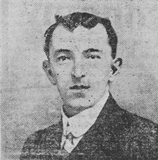
Owen Wynne Hughes, Private, 4144, Australian Infantry. Owen was the son of Edwin and Margaret Hughes, of Cefnmaes, Bala. He worked as a labourer prior to emigrating to Australia, and embarked at Liverpool for Adelaide aboard the SS Suevic on 25 October 1913. He found work as a Bush Worker, at Rockhampton, Queensland. Owen enlisted in Queensland into the 10th Reinforcements for the 25th Battalion, Australian Infantry on 20 September 1915. The unit embarked from Brisbane, Queensland, on board HMAT Commonwealth on 28 March 1916. The Reinforcements carried out further training in Egypt, while the 25th Battalion was already in France with the 2nd Australian Division, which had moved to the Nursery Sector near Fromelles, before moving to the Somme sector. On 16 July 1916 Owen joined up with the battalion on the Somme, in time to take part in the Battle of Pozieres. The battalion suffered terrible casualties at Pozieres, and Owen was wounded there on 5 August. He was evacuated via the 4th Field Ambulance and the 3rd Canadian Casualty Clearing Station to the 26th General Hospital, before being taken back to England, and was treated at Brighton Hospital. After recovering from his wounds, Owen was granted leave, returning to Bala for a short visit before re-joining his battalion on 9 February 1917. The 2nd Division was by now in front of the Hindenburg Line, and was in support during the Battle of Bullecourt. Owen was killed in action during the German counter-attack here on 20 April 1917, aged 29. He has no known grave and is commemorated on the Villers-Bretonneux Memorial, France.
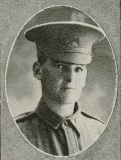
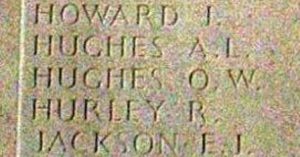
Maurice Humphreys, Driver, T4/174109, Army Service Corps. Maurice (or Morris) was the son of Humphrey and Mary Humphreys, of Castle Street, Bala. He married Ellen Hulse on 25 December 1900, and the couple resided in Rock Ferry, Birkenhead. Maurice enlisted into the Army Service Corps soon after the outbreak of war and was posted to France on 31 December 1915, joining the 479th Horse Transport Company, Army Service Corps. Maurice had only served in France for three months, when he became ill, and was invalided home. He died of pneumonia at Birkenhead on 19 April 1916, aged 38. He is buried in Bebington Cemetery, Cheshire.
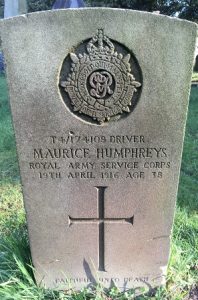
David Gwilym Jones, Private, 60946, Royal Welsh Fusiliers. David was the son of Joseph and Jane Jones, of 34, Mount Street, Bala. He worked as a farm labourer prior to the war. David enlisted at Bala into the Royal Welsh Fusiliers, and after completing his training, was posted to France, joining the 2nd Battalion, Royal Welsh Fusiliers, which was attached to 19 Brigade, 33rd Division. David probably joined the battalion in the Summer of 1917, following the Divisions efforts during the Battle of Arras, where it had suffered heavily at Bullecourt. At the beginning of July 1917 the Division withdrew from the front and headed to the area around Airaines for training. On 1 August the Division arrived at Bray Dunes, north of Dunkirk, and took over the line here, in readiness for a potential operation along the coast, code-named Operation Hush. Following the failure of the Allied offensive at Passchendaele to make real headway, Operation Hush was called off, and the 33rd Division sent to Ypres to take part in the offensive there. By 25 September the 2nd RWF was in support trenches in front of Polygon Wood, in readiness to take part in the assault on the wood the following day. At 10.50 on 26 September 1917 the battalion moved from their positions at Stirling Castle to Black Watch Corner, past the north of Glencorse Wood, to their starting positions, and formed up under heavy shellfire before launching their assault. David was one of many casualties suffered by the battalion during the days fighting. The 23-year-old has no known grave and is commemorated on the Tyne Cot Memorial, Belgium.
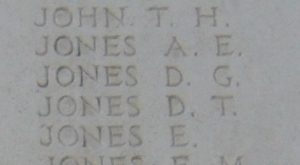
David Thomas Jones, Private, 203970, Royal Welsh Fusiliers. David was the son of Edward and Ann Jones, of Glanllyn Farmhouse, Llanuwchllyn. He worked as a Cowman at Berthlafar Farm prior to the war. David was conscripted into the army, but his employer took the case to the Military Appeals Tribunal, as he was a farmworker, but the Court ruled against his appeal and that of one other man, William Jones, a Shepherd, as there were five men working on the farm and they could be spared. As a result he enlisted into the 4th Battalion, Royal Welsh Fusiliers at Dolgellau on 21 February 1917. On 16 August 1917 David was posted to France, to No 5 Infantry Base Depot and on 30 August was posted to the 9th Battalion, Royal Welsh Fusiliers, which was in the Ypres Salient, attached to 58 Brigade, 19th (Western) Division. David would have seen his first major action during the Battle of the Menin Road soon afterwards, and during the Divisions actions during the fighting at Polygon Wood, Broodeseinde, Poelcapelle and Passchendaele Village. The Division then moved south, and from 21 March 1918 got caught up in the German Spring Offensive, taking part in heavy fighting as it withdrew over the coming days. David was badly wounded during the opening day of the offensive, on 21 March, and was evacuated to 48 Casualty Clearing Station for treatment. He was then transferred to the 7th Canadian General Hospital, at Étaples, where he died of his wounds on 15 April 1918, aged 20. He is buried in Étaples Military Cemetery, France.
Francis Jones, Private 2nd Class, 249084, Royal Air Force. Francis was born on 30 November 1897, the son of David and Annie Jones, of Ealing House, Bala. He worked as a Shop Assistant prior to enlisting into the Royal Navy on 1 February 1918, and was posted to HMS President II for training for the Royal Naval Air Service. The RNAS merged with the Royal Flying Corps to form the Royal Air Force soon afterwards, and Francis was posted to Roehampton to train in the use of Kite Balloons. Francis was then posted to Ireland. Francis took ill just prior to the war and died of influenza at Celbridge, County Kildare, on 26 October 1918, aged 20. His remains were brought home for burial in Christ Church Churchyard, Bala.
Hugh Edward Jones, Private, 241972, Royal Welsh Fusiliers. Hugh was the son of Edward and Gwen Jones, of Mount Street, Bala. He married Olive Carter, of Cardington, Shropshire, in 1912. The couple lived at 5, Water Street, Penmaenmawr prior to the war. Hugh enlisted into the 5th Battalion, Royal Welsh Fusiliers at some time in 1915. After completing his training, he was posted to Egypt in 1916, joining the 1/5th Battalion, Royal Welsh Fusiliers, which was attached to 158 Brigade, 53rd (Welsh) Division. The Division had been evacuated from Gallipoli in December 1915, moving to Egypt to join the EEF, and helped guard the Suez Canal before taking part in operations to drive the Turks out of the Sinai. The EEF then turned its attention onto driving the Turks out of Palestine, and on 26 March 1917 launched its first offensive against the coastal city of Gaza, which guarded the road to Jerusalem. Initial gains during the day were lost when the assaulting divisions lost touch with each other and communication broke down when a thick fog cloaked the battlefield. Hugh survived the battle, but was posted as missing two weeks later, on 10 April 1917. The 29-year-old was never seen again, and for some reason remained forgotten for 98 years until being identified and commemorated by the CWGC in 2015. His name was added to the Jerusalem Memorial, Israel.
Isaac Jones, Lance Corporal, 2630, Royal Welsh Fusiliers. Isaac was the son of Hugh Owen Jones, and Elinor Jones, of 30, Mount Street, Bala. He worked as a Railway Porter for the Great Western Railways, in the Traffic Department at Bala, prior to the war. He enlisted at Bala into the 7th Battalion, Royal Welsh Fusiliers. The battalion was a Territorial unit, which mobilised for war at Newtown in August 1914, as part of North Wales Brigade, Welsh Division and moved to Conway until the end of the month, before moving to Northampton. In December the Division moved to Cambridge and then in May 1915 to Bedford, where the Division was numbered and the formation became 158 Brigade, 53rd (Welsh) Division. On 19 July 1915 the entire Division sailed from Devonport for Imbros and on 9 August 1915 landed at Suvla Bay. Isaac survived the carnage which followed the landings at Gallipoli, but became ill in the terrible conditions towards the end of the campaign and was evacuated from the Peninsula aboard the Hospital Ship Axfordshire. He died of dysentery aboard the ship whilst en-route to Malta, on 3 January 1916, aged 19. Isaac is buried in Pieta Military Cemetery, Malta.
John Hugh Jones, Private, STK/2020, Royal Fusiliers. John was the son of Robert and Kate Jones, of Cyffdy, Bala. He was educated at Denstone College prior to gaining a position at Parr’s Bank, Crewe in 1912. Following the outbreak of war, John left his position to enlist into the Stockbrokers Battalion, Royal Fusiliers. John embarked for France at some time in 1916, and was posted to the 20th Battalion, Royal Fusiliers, which was known as the 3rd Public Schools Battalion. The battalion was attached to 19 Brigade, 33rd Division, and saw heavy fighting during the Somme offensive in the Summer of 1916. The Division then moved to the Arras sector, and took part in the Battle of the Scarpe during April 1917, before taking part in the Battle of Bullecourt, alongside the Australians, in May 1917. John was wounded during the latter stages of the battle, and died of his wounds on 29 May 1917, aged 23. He is buried in Sunken Road Cemetery, Boisleux-St. Marc, France.
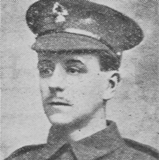
John Morris Jones, Private, B/19928, Royal Fusiliers. John was the son of Morris John Jones and Jane Jones, of Bradford House, Bala. He enlisted at St. Paul’s, London into the 26th (Bankers) Battalion, Royal Fusiliers. The battalion was raised by the Lord Mayor and City of London in July 1915, from Bank Clerks and Accountants, before moving to Aldershot, joining 124 Brigade, 41st Division. On 4 May 1916 the battalion embarked for France with the Division, which moved to the area of Ploegsteert and the Douve Valley, south of Ypres for trench familiarisation. The Divisions battalions then began to carry out the normal routines of rotation in the front, support and reserve lines over the coming months. On 23 July 1916 the 26th Royal Fusiliers relieved the 32nd Royal Fusiliers in the trenches to begin another tour. On the following day, the 41st Division artillery opened up a heavy artillery bombardment in front of the battalion, intended to cut the German wire defences, in readiness for a trench raid. The Germans retaliated with a bombardment of their own, which came down on the line at Long House Avenue, Rotten Row and St. Yves, killing John and one other man from the battalion. John was 22 years old when he was killed that day, and is buried in Berks Cemetery Extension, Belgium.
Richard Ambrose Jones, Private, 23403, Royal Welsh Fusiliers. Richard was the son of William and Hannah Jones, of Tegid Street, Bala. He married Elizabeth Ellis, of 9, Princess Street, Llangollen on 18 February 1915. Richard enlisted into the 13th Battalion, Royal Welsh Fusiliers early in 1915. The battalion was raised at Rhyl from 3 September 1914 by the Denbigh & Flint T.F. Associations and transferred to Welsh National Executive Committee on 10 October, before moving to Llandudno, joining 128 Brigade, 43rd (Welsh) Division. The Division trained in North Wales before moving to Winchester in the summer of 1915, where the formation became renumbered 113 Brigade, 38th (Welsh) Division. The Division moved to France on 2 December 1915 and moved to the Nursery Sector near Fleurbaix for trench initiation alongside the Guards Division. The Division then held a sector of the line near Cuinchy before marching south to the Somme sector in June 1916 to take part in the assault on Mametz Wood. By 12 July the Division had all but pushed the Germans out of the wood, before being relieved, and spent a month at Hébuterne before being transferred to the Canal Bank sector, north of Ypres. By the end of August 1916, the 13th RWF was at Chateau Les Trois Tours, resting and carrying out working parties. On 1 September 1916 Richard was on duty outside the Battalion Signal Office when a German shell crashed nearby, killing Richard and wounding four other men. Richard was 28 years old when he was killed that day, and is buried in Essex Farm Cemetery, Belgium.
Roger Llewelyn Jones, Private, 40089, Middlesex Regiment. Roger was born on 19 October 1891, the son of William Edward Jones and Anna Jones (nee Edwards), of Heulwen, Bala. After leaving school, Roger joined the National Provincial Bank at Whitchurch, and took up a position at Bute Docks, in Cardiff, in June 1915. He originally enlisted into the Bankers Battalion, Royal Fusiliers at Cardiff on 12 December 1915, and after completing his training was transferred to the 12th Battalion, Middlesex Regiment on 31 August 1916. The battalion had moved to France on 26 July 1915, attached to 54 Brigade, 18th (Eastern) Division. Roger joined the battalion on the Somme on 1 September 1916. The Division had moved into the Somme sector in order to take part in the great offensive and in October took part in the Battle of the Ancre Heights, capturing Schwaben Redoubt, and helped capture Regina Trench. The Division then fought at the Battle of the Ancre, and during the subsequent Operations on the Ancre, before spending the winter on the Somme. Roger was killed in action during a period of routine trench warfare near Courcelette on 17 February 1917, aged 25. He is buried in Regina Trench Cemetery, Grandcourt, France.
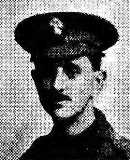
Thomas Jones, Private, 29606, Royal Welsh Fusiliers. Thomas was the son of John and Elizabeth Ann Jones, of Hendre, Maerdy. He was educated at Bala County Boys’ School before training as a Teacher, then went back to education at Bangor University. He had just completed his course there when he enlisted into the Royal Welsh Fusiliers at Bangor on 9 December 1915, and was posted to the 21st Battalion, Royal Welsh Fusiliers at Kinmel Park. On 16 June 1916 Thomas embarked for France, and was posted to the 38th Infantry Base Depot at Étaples. From there, Thomas was posted to the 17th Battalion, Royal Welsh Fusiliers, which was attached to 113 Brigade, 38th (Welsh) Division, joining the battalion on 30 June 1916. The Division had only just moved south from Flanders, and Thomas joined the battalion in billets at Toutencourt. Over the coming days the Division moved forwards into positions south of Mametz Wood, with orders to attack and clear the vast wood. The first attack on the wood was launched on a two-battalion front on 7 July, but failed, and the Divisional Commander, Sir Ivor Philipps, was replaced before the Division attacked again on a two Brigade front on 10 July 1916. Fighting raged for two days, until the Division was relieved on 12 July and moved to positions in the line at Hébuterne to rest and rebuild. Thomas survived the ferocious fighting in Mametz Wood, but was wounded in the Hébuterne trenches on 20 July 1916, being shot in the chest. He was slowly evacuated back via the 27th Field Ambulance to the 21st Casualty Clearing Station, and received further treatment at No 18 General Hospital, Abbeville before landing back in England, and was taken to Leith War Hospital, Seafield, Leith, in Edinburgh. The wound by now had become septic, and Thomas eventually died of blood poisoning, due to his wounds, on 27 August 1916, aged 21. His remains were conveyed home, and he was buried with full military honours in Cefnddwysarn Calvinistic Methodist Chapelyard.
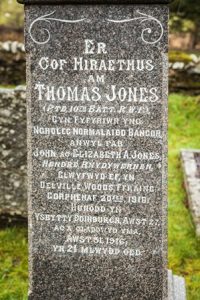
Thomas Jones, Private, 30656, Border Regiment. Thomas was the son of John and Jane Jones, of Ty Capel, Llwynhenion, Bala. He lived with his wife, Elizabeth Jones, at 6, Blaenddol, Bala prior to the war. Thomas enlisted at Bala into the Royal Welsh Fusiliers at some time in 1917, and after completing his training, was posted to France, where he was transferred to the 7th Battalion, Border Regiment. The battalion was formed at Carlisle in September 1914, attached to 51 Brigade, 17th (Northern) Division, and had landed in France on 15 July 1915. Two years later it absorbed the men of the Westmorland & Cumberland Yeomanry. Thomas possibly joined up with the battalion following the Divisions actions during the German Spring Offensive in March 1918, after which it was moved out of the line to rest and rebuild. The Division then moved to the southernmost sector of the Somme area, where it fought at the Battle of Amiens on 8 August 1918, a day which saw the war swing in the favour of the Allies. The Division then joined the general advance towards the Hindenburg which followed, from 21 August 1918 onwards, taking part in the Battle of Albert later that month, then on to the Battle of Bapaume on 31 August. It then took part in the Battle of Havrincourt on 12 September and the Battle of Épehy on 18 September. At the beginning of October the mighty Hindenburg Line was broken, and the 17th Division swept towards Cambrai, fighting at the Battle of Cambrai on 8 October, and then north-east through northern France, towards the old Battlefields of Mons and Le Cateau, during the Pursuit to the Selle and the Battle of the Selle during the middle of October. Thomas was badly wounded during the Divisions attack across the Selle, near Montigny, on 20 October, and died of his wounds the following day, 21 October 1918, aged 35. He is buried in Awoingt British Cemetery, France,
William Jones, Private, 144765, Machine Gun Corps. William was the son of John Jones, of 17, Edward Street, Maerdy. He worked as a Cowman at Berthlafar Farm, Bala prior to the war. William enlisted at Dolgellau into the Royal Welsh Fusiliers, and upon being posted to France, probably in the summer of 1917, was transferred to the 38th Company, Machine Gun Corps, which was attached to the 38th (Welsh) Division. He would have most likely joined the Division after its assault on the Pilckem Ridge on 31 July 1917. Following further action at Langemarck, the Division moved to the Erquinghem Lys area and wintered there before moving south to the Somme at the end of March, to relieve the battered 2nd and 47th Divisions in the line north of Albert. The Division remained in this sector over the coming months, before launching its offensive across the flooded Ancre Valley on 21 August 1918 and beginning its part in the Advance to Victory, towards the mighty Hindenburg Line. The Division pushed across the old Somme battlefield over the coming weeks and by 11 September had reached Etricourt. On 19 September 1918 William was with his Company, supporting the Divisions assault on Dessart Wood, when he was killed in action. William has no known grave and is commemorated on the Vis-en-Artois Memorial, Haucourt, France.
Rhodri Deane Owen-Jones, Captain, Indian Army. Rhodri was born at Banstead, Surrey on 14 August 1886, the son of Major General Robert Owen-Jones, CB (Royal Engineers), and of Harriett Owen-Jones (nee Deane), of Bryntegid, Bala. He was educated at the Royal Military College, Sandhurst, and after passing out was commissioned on 25 January 1908 into the 1st Battalion, South Lancashire Regiment, which was in India. He joined the 36th Jacob’s Horse on 19 March 1909, and served with the regiment continually until the outbreak of war. The 36th Jacob’s Horse was part of the 8th (Lucknow) Cavalry Brigade, 1st Indian Cavalry Division, and sailed from Bombay for France on 16 October 1914. Rhodri was wounded on 10 January 1915, and invalided home for three months. Upon his return he was promoted to Captain. Rhodri was accidentally killed whilst at grenade practise on 5 January 1916, aged 29. He is buried in Abbeville Communal Cemetery, France.
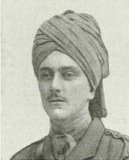
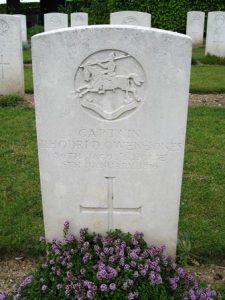
John Cadwaladr Owen, Private, 24913, Queen’s Royal West Surrey Regiment. John was born in Criccieth in 1897, the son of David and Elizabeth Owen, of Braich-y-Saint. Around the time that war erupted, John was living in Church Road, Bala, where he had come to work in the London City and Midland Bank. John enlisted at Bala into the army, and was first posted to the East Kent Regiment (The Buffs). He was then transferred to the 10th Battalion, Queen’s Own Royal West Surrey Regiment. The battalion was raised on 3 June 1915 by the Mayor and Borough of Battersea, before joining 124 Brigade, 41st Division, before moving to Stanhope Lines, Aldershot. On 6 May 1916 the battalion landed at Havre, and the entire Division moved to the Ploegsteert and Douve Valley area for trench initiation. The Division moved to the Somme in August and fought in the great offensive there, before moving to positions south of Ypres in 1917. It then took part in the Battle of Messines. The Division saw further fighting during the Third Battle of Ypres, before being selected to move to Italy, and arrived at Mantua on 17 November 1917, where they held a part of the line on the River Piave. Following the German Spring offensive on 21 March 1918, the Division was rushed back to Flanders, and saw action during the First Battle of Arras, before being withdrawn, and sent north to Ypres, taking over the Passchendaele sector. On 27 April 1918 John’s battalion was in the front line, on the St. Jean Road, when a German shell fell into a bay, killing John and another man. John was 21 years old when he was killed that day, and was buried by his comrades in Ypres Town Cemetery Extension, Belgium. He is also commemorated on the war memorials at Criccieth and Pentrefelin.
Charles Pettit, Private, 291252, Royal Welsh Fusiliers. Charles was the son of Alice May Pettit, of 39, Church Square, Bedford. Charles had come to Bala to work as a Groom for Colonel William Blakeway Burton, of Eryl Aran, Bala, prior to the war. He enlisted at Bala into the 7th Battalion, Royal Welsh Fusiliers on 19 November 1915. He was posted to the 3/7th Battalion, Royal Welsh Fusiliers at Park Hall, Oswestry for training, before embarking for Egypt on 4 September 1916, joining the 1/7th Battalion, Royal Welsh Fusiliers, which was attached to 158 Brigade, 53rd (Welsh) Division. The Division had been evacuated from Gallipoli in December 1915, moving to Egypt to join the EEF, and helped guard the Suez Canal before taking part in operations to drive the Turks out of the Sinai. The EEF then turned its attention onto driving the Turks out of Palestine, and on 26 March 1917 launched its first offensive against the coastal city of Gaza, which guarded the road to Jerusalem. Initial gains during the day were lost when the assaulting divisions lost touch with each other and communication broke down when a thick fog cloaked the battlefield. A second attempt to force Gaza was launched on 17 April, but again failed, so the EEF was re-organised under a new commander, Sir Edmund Allenby, before it went on the offensive again. The Third Battle of Gaza was launched on the night of 1/2 November on a front running from Gaza to Beersheba. Charles was killed in action during fighting to the north of Beersheba on 6 November 1917, aged 23. He is buried in Beersheba War Cemetery, Israel.
Owen Wyndham Richards, Private, 34596, Labour Corps. Owen was the son of John and Elizabeth Richards, of Menafon, Bala. He was raised by his Uncle and Aunt, Evan and Elizabeth Evans, at 31, Mount Street, Bala. Owen worked as a Telegraph Messenger at Llanidloes prior to the war. He enlisted at Wrexham into the King’s (Liverpool Regiment), but was then transferred into the 58th Company, Labour Corps. Little else is presently known of him, but Owen was killed in action near Ypres on 27 June 1917, aged 22. He is buried in Ferme Olivier Cemetery, Ieper, Belgium.
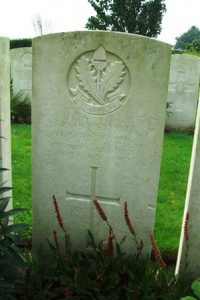
Robert John Richards, Private, 89572, Royal Welsh Fusiliers. Robert was the son of David and Margaret Sydney Richards, of 6, Arenig Terrace, Bala. He enlisted into the Royal Welsh Fusiliers in Wrexham late in the war, and was posted out to France at some time in 1918, joining the 2nd Battalion, Royal Welsh Fusiliers. The battalion was by then attached to 115 Brigade, 38th (Welsh) Division, and was on the Somme, in the line north of Albert. The Division had moved there at the end of March 1918, relieving the battered 2nd and 47th Divisions, and remained in this sector until launching its offensive across the flooded Ancre Valley on 21 August 1918. The Division then pushed its way across the old Somme battlefields of 1916, towards the Canal du Nord and the mighty Hindenburg Line. On 29 September the Hindenburg Line was breached and the 38th Division was on the south of the River Selle by 13 October, preparing to cross the river. Robert was killed in action here on 18 October 1918, aged 21, just before the 2nd RWF was relieved and moved back into billets. He has no known grave and is commemorated on the Vis-en-Artois Memorial, Haucourt, France.
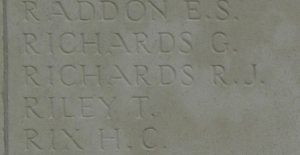
Edward Roberts, Private, 74182, Sherwood Foresters. Edward was the son of John and Ann Roberts, of Cwmtirmynach, Bala. He worked as a Cowman prior to enlisting at Dolgellau into the 4th Reserve Battalion, Royal Welsh Fusiliers on 28 February 1917. Edward was posted to Park Hall, Oswestry for training, and on 20 July 1917 embarked for France, arriving at the Infantry Base Depot at Rouen. On 25 August 1917 he was posted to the 19th Battalion, Royal Welsh Fusiliers, which was attached to 119 Brigade, 40th (Bantam) Division. Edward would have then taken part in the Divisions assault on Bourlon Wood, during the Battle of Cambrai, from 20 November, and during the terrible fighting which followed when the Germans counter-attacked. The Division wintered in the Cambrai sector, and when the army was re-organised in February 1918, the 19th RWF was disbanded, and following two weeks leave to England, Edward was transferred to the 10th Battalion, Sherwood Foresters (Notts and Derby Regiment). The battalion was attached to 51 Brigade, 17th (Northern) Division, and was in the same sector. The 17th Division was caught up by the German Spring Offensive of 21 March 1918, seeing heavy fighting near Hermies, and during its subsequent retreat towards Bouzincourt, before moving back into reserve. On 6 April Edward joined the battalion, as part of a draft of 216 men of the 19th RWF. The 10th Sherwood Foresters then moved into the front line near Mesnil and set to work improving the trenches. On 16 April 1918 the battalion was still in the line at Mesnil when it came under heavy artillery fire from the Germans. Edward was badly wounded during the barrage, and died later that same day. The 22-year-old is buried in Varennes Military Cemetery, France.
Frederick Roberts, Private, 34609, Royal Welsh Fusiliers. Frederick was born in Bala in 1887, the illegitimate son of Hugh Davies and Elizabeth Roberts. His mother married Henry Durant, before moving to Guildford by 1891, and Frederick was raised by his Uncle and Aunt, Cadwaladr and Margaret Jones, at 12, Aran Lane, Bala before joining his mother at Eastwood Road, Bramley, Guildford, Surrey. Frederick worked as a Tanner prior to enlisting at Holborn into the 18th Battalion, Royal Welsh Fusiliers (2nd London Welsh) on 25 October 1915. On 16 March 1916 he was posted to the 38th Infantry Base Depot in France, and on 4 April was posted to the 14th Battalion, Royal Welsh Fusiliers, which was attached to 113 Brigade, 38th (Welsh) Division. He joined the battalion at Le Touret, just prior to a move to Givenchy, and took part in several raids and operations with the Division over the coming days. Frederick was wounded a week later, on 11 April, and was treated at the 32nd Casualty Clearing Station before re-joining the battalion on 6 May. The battalion was by then at Rue Tilleloy, and remained in this area until the entire Division moved south to the Somme sector in the middle of June. By 6 July the Division had taken up positions to the south of Mametz Wood, with orders to assault and clear it. The first attack on the wood was launched on a two-battalion front on 7 July, but failed, and the Divisional Commander, Sir Ivor Philipps, was replaced before the Division attacked again on a two Brigade front on 10 July 1916. Frederick is recorded as having been killed in action at Mametz Wood on 9 July 1916, aged 29. His service papers actually state that he was missing, presumed killed in action at some time between 9 and 12 July, such was the carnage and chaos within the wood. He has no known grave and is commemorated on the Thiepval Memorial, France.
John Roberts, Private, 35194, Cheshire Regiment. John was the son of James and Mary Roberts, of Brynbannon Bach, Bala. He worked as a Warehouseman in Birkenhead prior to the war. He enlisted in Liverpool into the 14th Battalion, Cheshire Regiment on 10 December 1915, and was posted to Prees Heath for training. On 19 July 1916 he embarked for France and was posted to No 4 Infantry Base Depot at Rouen. On 27 July John was posted to the 13th Battalion, Cheshire Regiment, which was attached to 74 Brigade, 25th Division. He joined the Division on the Somme, and would have taken part in several of the Divisions engagements throughout the offensive. On 15 October 1916 he was taken ill with pneumonia and spent two weeks in hospital before re-joining the battalion. By November the Division had moved to Flanders, and was near Meteren, and took over a section of the front at Ploegsteert Wood. John was wounded whilst the battalion was in the line near Le Touquet, and died of his wounds on 2 February 1917, aged 27. He is buried in Bailleul Communal Cemetery Extension, France.
John Roberts, Private, US Army. John was born on 26 November 1889, the son of Edward and Elizabeth Roberts, of Werglodd Goch, Bala. He emigrated to America in April 1912, and moved to Postville, Nebraska, where he lodged with John T. Evans. John enlisted into the US Army in September 1917 and was posted to Fort Riley, Kansas for training with Company D, 314th Ammunition Train. Robert took ill during the winter and died of pneumonia and diphtheria on 22 January 1918, aged 28. His remains were brought back to Postville for burial in the Welsh Chapel Cemetery, Postville, Nebraska. His sister Jane, who lived in Hartford, Connecticut, attended his funeral.
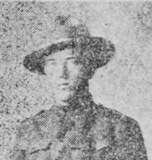
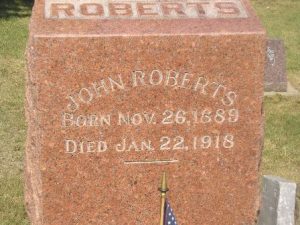
Robert Roberts, Private, 291171, Royal Welsh Fusiliers. Robert was the illegitimate son of Ellen Rowlands (nee Roberts), of Bala. He lived with his wife, Mary Roberts, at 39, Mount Street, Bala. Robert enlisted at Bala into the 3/7th Battalion, Royal Welsh Fusiliers on 29 October 1915. He was posted to Park Hall, Oswestry with the battalion for training. On 21 October 1916 Robert embarked for Egypt, joining the 1/7th Battalion, Royal Welsh Fusiliers. The battalion was attached to 158 Brigade, 53rd (Welsh) Division, and had been evacuated from Gallipoli in December 1915, moving to Egypt to join the EEF, and helped guard the Suez Canal before taking part in operations to drive the Turks out of the Sinai. The EEF then turned its attention onto driving the Turks out of Palestine, and on 26 March 1917 launched its first offensive against the coastal city of Gaza, which guarded the road to Jerusalem. Initial gains during the day were lost when the assaulting divisions lost touch with each other and communication broke down when a thick fog cloaked the battlefield. Robert was wounded during the fighting that day, suffering gunshot wounds to the groin, and was evacuated to the 24th Stationary Hospital at Alexandria where he died of his wounds on 1 April 1917, aged 41. Robert is buried in Kantara War Memorial Cemetery, Egypt. Two of his half-brothers, Ellis Rowlands and Evan David Rowlands, also fell, and are commemorated at Llanuwchllyn, as is Robert himself.
Arthur Rogers, Second Lieutenant, Royal Welsh Fusiliers. Arthur was born in Llanwnda, Caernarvonshire in 1897, the son of Reverend John Rogers and Annie E. Rogers. By 1911 the family had moved to Bronwylfa, Bala, and Arthur was educated at the Bala County School. Arthur worked for the Welsh National Insurance Committee at Cardiff prior to enlisting at Cardiff into the 6th Battalion, Royal Welsh Fusiliers in November 1915. Arthur was posted to Egypt on 14 December 1916, and joined the 6th Battalion, Royal Welsh Fusiliers, which was attached to 158 Brigade, 53rd (Welsh) Division. The Division had been evacuated from Gallipoli in December 1916, moving to Egypt to join the EEF, and helped guard the Suez Canal before taking part in operations to drive the Turks out of the Sinai. The EEF then turned its attention onto driving the Turks out of Palestine, and on 26 March 1917 launched its first offensive against the coastal city of Gaza, which guarded the road to Jerusalem. Initial gains during the day were lost when the assaulting divisions lost touch with each other and communication broke down when a thick fog cloaked the battlefield. Arthur was killed in action during the fighting that day. He was 20 years old and is buried in Gaza War Cemetery.
Daniel Thomas, Private, 26395, Royal Welsh Fusiliers. Daniel was the son of Daniel Thomas, of Barracks, Penybryn, Festiniog. He worked as a farm labourer prior to the war, and lived at Hafod yr Escob, Cwmtirmynach, Bala. He enlisted at Bala into the 17th Battalion, Royal Welsh Fusiliers on 22 July 1915, and was posted to Llandudno to join the battalion, which was training there, attached to 115 Brigade, 38th (Welsh) Division. The Division moved to Winchester in the summer of 1915, and Daniel embarked for France with the 17th RWF on 5 December 1915. The Division moved to the Nursery Sector near Fleurbaix for trench initiation alongside the Guards Division. It then held a sector of the line near Cuinchy before marching south to the Somme sector in June 1916 to take part in the assault on Mametz Wood. Following its efforts in clearing the wood, from 7 to 12 July, the Division was relieved, and had a short spell at Hébuterne before taking over the Canal Bank sector of the line north of Ypres. On 31 July 1917 the Division launched its assault on the Pilckem Ridge, and saw heavy fighting over the coming days. Daniel was wounded here on 5 August, being shot in the left leg, and was treated in Hospital in Boulogne before returning to England. On 17 February 1918 he arrived back in France, and was posted to the 2nd Battalion, Royal Welsh Fusiliers, which was attached to 115 Brigade, 38th (Welsh) Division. The Division moved to the Somme at the end of March, relieving the battered 2nd and 47th Divisions in the line north of Albert, and soon afterwards, Daniel was wounded again. On 20 June 1918, whilst home on leave, Daniel married Mary Edwards, of Bont-yr-Afon Garn, Festiniog. He returned to France, re-joining the battalion near Albert. Daniel was wounded soon afterwards, suffering gunshot wounds to his right thigh, and was treated at the 7th Canadian Stationary Hospital at Étaples, before re-joining the battalion again on 28 September. By now the Division was taking part in the great advance to the Hindenburg Line, and saw much fighting before taking part in its last major action, the Battle of the Sambre, on 4 November 1918. Daniel was killed in action during heavy fighting that day. He was 23 years old and is buried in Montay-Neuvilly Road Cemetery, Montay, France.
David John Thomas, Private, 61022, Royal Welsh Fusiliers. David was the son of David and Ellen Thomas, of Garthlwyd Farm, Bala. He enlisted into the 3rd Battalion, Royal Welsh Fusiliers and was posted to Litherland Camp, Liverpool for training. David took ill whilst at Litherland and died of pneumonia at Stanley Hospital, Kirkdale, Liverpool on 20 February 1917, aged 27. His remains were brought home for burial in St. Beuno’s Churchyard, Llanycil.
John Thomas, Private, 16791, Royal Welsh Fusiliers. John was the son of John and Jane Thomas, of 53, Llechwedd Hen, Bala. He worked as a Carter prior to enlisting at Welshpool into the 9th Battalion, Royal Welsh Fusiliers soon after the outbreak of war. The battalion formed at Wrexham before moving to Tidworth, joining 58 Brigade, 19th (Western) Division. The battalion moved to France on 19 July 1915, and moved with the division to positions near Givenchy, where it began trench familiarisation. By September 1915 the Division was holding the line at Festubert, and from there took in a diversionary attack on 25 September 1915, aimed at diverting German attention away from the main offensive at Loos. The assault was futile from the start, and hundreds of lives were lost needlessly in the attempted dash across No Man’s Land. The 9th RWF alone suffered 249 casualties, including John, who had been killed in action during the day. The 46-year-old has no known grave and is commemorated on the Loos Memorial, France.
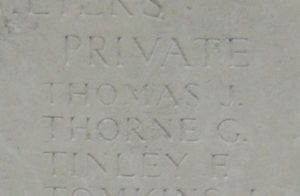
Herbert Watson, Sergeant, 15433, Royal Welsh Fusiliers. Herbert was the son of William and Maria Watson, of Boots Farm, Wimblington, Cambridgeshire. By 1911 he was living at the White Lion Hotel at Bala, where he worked as a Billiard Marker. He enlisted at Bala soon after the outbreak of war, joining the 10th Battalion, Royal Welsh Fusiliers. The battalion formed at Wrexham, joining 76 Brigade, 25th Division at Codford St. Mary, Salisbury Plain, and embarked for France with the Division on 27 September 1915. Three weeks later, 76 Brigade transferred to the 3rd Division, south of Ypres. In the Spring of 1916, the Division fought at the Actions of the Bluff, and at the St Eloi Craters. It was then moved south to the Somme, and fought there at the Battle of Albert, and the Battle of Bazentin, where the Division captured Longueval. They then took part in the Battle of Delville Wood, where two men of the 10th RWF gained the award of the Victoria Cross. The Division then fought at the Battle of the Ancre, before settling into a bleak winter in France. By February 1917 the Division had moved into the Arras sector and from 8 April became caught up in the Battle of Arras, attacking the ruined village of Guemappe. Herbert was killed in action here on 11 April 1917, aged 28. He has no known grave and is commemorated on the Arras Memorial, France.
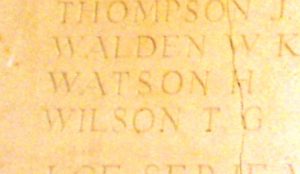
James Watson, Rifleman, 240405, South Lancashire Regiment. James was born as James Watson Roberts, the son of John Watson and Gwen Watson (nee Roberts), of Tynewydd, Llanycil, Bala. His parents married soon after his birth, and James grew up as James Watson. He enlisted at St. Helen’s into the South Lancashire Regiment under the name of James Watson Jones, and was posted to France with the 1/5th Battalion, South Lancashire Regiment on 13 February 1915. The battalion initially jones 12 Brigade, 4th Division, and moved to Ypres, taking part in the Second Battle of Ypres. On 4 November 1915, 12 Brigade transferred to the 36th (Ulster) Division, before the 1/5th South Lancs transferred on 6 January 1916 to 166 Brigade, 55th (West Lancs) Division at Arras. On 25 July, the Division moved south and took part in the Battle of Guillemont and the Battle of Ginchy. The Division enjoyed a short rest before taking part in the Battle of Flers-Courcelette and the Battle of Morval. The Division then moved to Ypres in October 1916, taking over the Railway wood sector until taking part in the Battle of Pilkem Ridge. Following heavy casualties, the Division moved out of the line to rebuild before moving back into the line on 15 September, and fighting at the Battle of the Menin Road. The Division moved south from 22 September, taking up positions near Honnecourt wood and Lempire-Ronssoy, and fought at the Battle of Cambrai. The Division faced the enemy counter attack on 30 November 1917, and became caught up in terrible fighting over the coming days, which saw the 1/5th Battalion, South Lancs totally annihilated. James is recorded as having been killed in action during this terrible period, on 2 December 1917, aged 29. He is buried in Honnechy British Cemetery, France.
David Morris Williams, Private, 20223, Royal Welsh Fusiliers. David was the son of David and Sarah Williams, of Belle View, Tan-y-Bwlch. He worked at Brynpader Farm prior to the war. He enlisted at Blaenau Ffestiniog into the 14th Battalion, Royal Welsh Fusiliers soon after the outbreak of war. The battalion was raised at Llandudno by the Welsh National Executive Committee, joining 128 Brigade, 43rd (Welsh) Division and trained in North Wales before moving to Winchester in the summer of 1915, where the formation became renumbered 113 Brigade, 38th (Welsh) Division. The Division moved to France on 2 December 1915 and moved to the Nursery Sector near Fleurbaix for trench initiation alongside the Guards Division. The Division then held a sector of the line near Cuinchy before marching south to the Somme sector in June 1916 to take part in the assault on Mametz Wood. The first attack on the wood was launched on a two-battalion front on 7 July, but failed, and the Divisional Commander, Sir Ivor Philipps, was replaced before the Division attacked again on a two Brigade front on 10 July 1916. On 12 July the battered Division was relieved and moved to the front at Hébuterne for a month, before taking over the Canal Bank sector north of Ypres. David was seriously wounded during a trench raid there in April 1917. He was brought back to Maesteg Hospital for treatment, and upon recovering visited his parents before embarking again for France. He was then posted to the 16th Battalion, Royal Welsh Fusiliers, which was also attached to 113 Brigade, 38th (Welsh) Division. On 31 July 1917 the Division launched its assault on the Pilckem Ridge, and fought its way across the mud to its objectives of Iron Cross and the Steenbeek. David was killed in action here at some time during the day. He was 19 years old and is buried in Dragoon Camp Cemetery, Belgium.
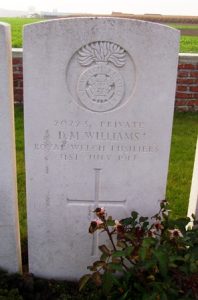
Evan Robert Williams, Private, 49699, Royal Welsh Fusiliers. Evan was the son of Evan and Margaret Williams, of Werngoch, Bala. He lived at Abergeirw, Llanfachreth prior to enlisting at Dolgellau into the 7th Battalion, Royal Welsh Fusiliers. The battalion was a Territorial unit, which mobilised for war at Newtown in August 1914, as part of North Wales Brigade, Welsh Division and moved to Conway until the end of the month, before moving to Northampton. In December the Division moved to Cambridge and then in May 1915 to Bedford, where the Division was numbered and the formation became 158 Brigade, 53rd (Welsh) Division. On 19 July 1915 the entire Division sailed from Devonport for Imbros and on 9 August 1915 landed at Suvla Bay. The Division was evacuated from Gallipoli in December 1915, moving to Egypt to join the EEF, and helped guard the Suez Canal before taking part in operations to drive the Turks out of the Sinai. The EEF then turned its attention onto driving the Turks out of Palestine, and on 26 March 1917 launched its first offensive against the coastal city of Gaza, which guarded the road to Jerusalem. At some time after this, Evan was transferred to the 2nd (Garrison) Battalion, Royal Welsh Fusiliers, which was on garrison duty in Egypt. He survived the war, but died of pneumonia in hospital in Alexandria on 12 January 1919, aged 26. Evan is buried in Alexandria (Hadra) War Memorial Cemetery, Egypt.
William Williams, Private, 43934, Royal Welsh Fusiliers. William was the only son of John and Jane Williams, of Penybanc, Sarnau, Llandderfel. He enlisted at Wrexham into the Royal Welsh Fusiliers, and after completing his training was posted to France, joining the 10th Battalion, Royal Welsh Fusiliers, which was attached to 76 Brigade, 3rd Division. William probably joined the battalion at the end of 1916, following its exploits at Delville Wood, and the Battle of the Ancre. By February 1917 the Division was at Arras, and from 9 April took part in the First Battle of the Scarpe. From 23 April the Division then fought in the Second Battle of the Scarpe, and also in the ensuing Battle of Arleux and the Third Battle of the Scarpe, where the Division captured Roeux. After a brief rest period to recover from its efforts at Arras, the Division went into reserve, before taking up the line again by 12 June, near Monchy and took part in another attack on 14 June. The Germans counter-attacked the following day, beginning a series of tit-for-tat actions over the coming days. William was badly wounded during this period, and died of his wounds in hospital at Etaples on 20 June 1917, aged 24. He is buried in Etaples Military Cemetery, France.
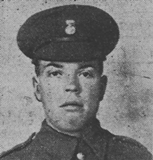
William Williams, Private, 204283, Royal Welsh Fusiliers. William was the son of Hugh and Ellen Williams, of Croeslon, Rhyducha, Bala. He worked on his father’s farm prior to enlisting at Dolgellau into the 4th Reserve Battalion, Royal Welsh Fusiliers. After completing his training, William was posted to France, joining the 16th Battalion, Royal Welsh Fusiliers, which was attached to 113 Brigade, 38th (Welsh) Division. He probably joined the battalion near Armentieres, prior to its move south to the Somme at the end of March 1918, where it relieved the battered 2nd and 47th Divisions in the line north of Albert. Facing the Division was Bouzincourt Ridge, which afforded an advantage to the Germans, so the Divisions planned to assault and take the ridge. The responsibility was given to 113 Brigade to take the ridge, so at 07.30 on 22 April 1918 the Brigade, together with the 2nd RWF, launched its assault. The line was advanced some 250 yards, but at a heavy cost. William was killed in action at some time during the attack that day. The 30-year-old has no known grave and is commemorated on the Pozieres Memorial, France.
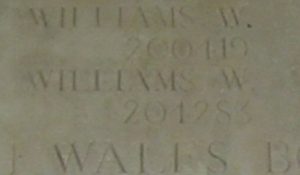
World War Two, 1939-1945
Edward Henry Edmonds, Sergeant, 554011, Royal Air Force. Edward was the son of Henry John and Hilda Edmonds, of Bala. He married Joan Roberts in Wrexham early in 1943. Edward enlisted into the Royal Air Force, and served with 150 Squadron, RAF, which was originally equipped with the Fairey Battle. In October 1940 the squadron converted to the Vickers Wellington, and became a night bomber squadron, at first with Bomber Command in Britain, before moving to Algeria in December 1942. The squadron supported the Allied invasion of Italy in 1943, flying from bases in North Africa. On 24 October 1943, Edward was flying aboard Wellington XIV, Serial HF482, as part of a flight sent to bomb the airfield at Guidonia. His Wellington collided with another from the flight, and crashed near Rome, killing all her crew. Edward and his fellow crewmen were originally buried in Marcellina Cemetery, but after the war their graves were exhumed and re-interred in Rome War Cemetery, Italy.
Catherine Ellen Evans, Aircraftwoman 1st Class, 439648, Women’s Auxiliary Air Force. Catherine was the daughter of Edward Griffith Evans and Catherine Jane Evans. She enlisted into the Women’s Auxiliary Air Force, and was posted to No 53 OTU, at Llandow. On 21 October 1942 Catherine was driving a fuel tanker, when it caught fire and exploded following an accident, fatally injuring her. She died that same day. Catherine was 23 years old and her remains were brought home for burial in St. Beuno’s Churchyard, Llanycil.
Iorwerth Francis Evans, Corporal, 4192625, Royal Welch Fusiliers. Iorwerth was born at Bala in 1915. He enlisted into the 2nd Battalion, Royal Welch Fusiliers soon after the outbreak of war, and while stationed in London married Lucille Florence Briggs in 1940. Iorwerth was posted to Madagasgar in 1942, and died aboard ship on the voyage, on 8 May 1942, aged 27. He was buried at sea, so is commemorated on the Brookwood Memorial, Surrey.
Alan Edward Goddard, Captain, 201922, Royal Army Service Corps. Alan was born on 28 January 1914, the son of Ernest and Dora Kate Goddard, of Prestatyn. He worked as a Solicitor prior to the war and lived at Ranville, Bala. Alan married Agnes MacDonald, of Bonnybridge, following the outbreak of war. On 16 August 1941 Alan was commissioned from the OCTU into the Royal Army Service Corps and within three years had been promoted to Captain. He died following a road accident in Surrey on 28 April 1944, aged 30, and his remains were conveyed to Scotland for burial in Denny and Dunipace Cemetery, Falkirk.
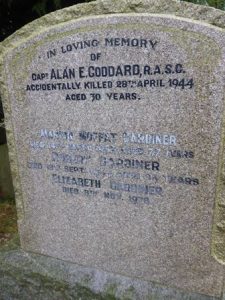
Frederick Edward Hughes, Boy 1st Class, P/JX 157826, Royal Navy. Frederick was born at Corwen on 12 February 1923, the son of Edward David Hughes and Flossie Daisy Hughes (nee Printer). The family later resided at Plastec, Bala. He enlisted into the Royal Navy prior to the war, and after completing his training was posted aboard the Revenge-class Battleship HMS Royal Oak. She had been completed in 1916 and saw service in the Battle of Jutland. She continued to serve in the Royal Navy between the wars, but was found to be too slow for front line duty, and was confined to defensive duties in the Royal Naval base at Scapa Flow. At just after midnight on 14 October 1939, Royal Oak was anchored safely in Scapa Flow, with most of her crew asleep. The German submarine U-47, under the command of Gunther Prien, had sneaked into the anchorage past its torpedo nets, and fired a salvo of three torpedoes, one of which struck Royal Oak in the bow. The explosion awoke the crew, who thought there had been an internal explosion within the ship, but soon afterwards, U-47 fired another salvo of torpedoes at her, which detonated one of her magazines, sending a fireball through the ships compartments, before she turned over and sank. Around 835 men died as a result of the sinking, a catastrophe which was hailed as a great success in Germany. Frederick was just 17 years old when he was killed in the sinking of Royal Oak. He has no known grave and is commemorated on the Portsmouth Naval Memorial, Hampshire.
John Arthur Hughes, Gunner, 947436, Royal Artillery. John was the son of Richard and Mary Hughes, of Mount Street, Bala. He enlisted into the Royal Artillery and was posted to the 69th (The Denbighshire Yeomanry) Medium Regiment, Royal Artillery. The battery served with the BEF in 1940, being evacuated from Dunkirk. During 1942 it was sent to North Africa, taking part in the Battle of El Alamein and the subsequent drive to push Rommel out of Tunisia. John was killed during a period of German offensives on 1 March 1943, aged 24. He has no known grave and is commemorated on the Medjez-el-Bab Memorial, Tunisia.
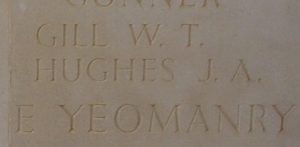
Henry Jones, Ordinary Seaman, LT/JX 240557, Royal Naval Patrol Service. Henry was born on 5 May 1914, the son of John Owen and Catherine Jane Jones, of New Shop, Bala. He enlisted into the Royal Navy, and was posted to the Royal Naval Patrol Service, a branch of the Navy which operated small boats on Anti-Submarine and minesweeping operations. He was posted aboard the requisitioned trawler, HMT Fortuna, which had been converted into an auxiliary patrol vessel. On 3 April 1941, Fortuna was on operations in the Firth of Forth when she was attacked and sunk by German aircraft off St. Abbs Head. Henry was 26 years old when he was killed during the sinking. His body was recovered from the water and he is buried in Berwick-Upon-Tweed Cemetery.
Hugh Cory Jones, Private, 7648537, Royal Army Ordnance Corps. Hugh was born at Liverpool on 7 April 1916, the son of Andrew Jones and Gertrude Jones (nee Richardson). He married Freda Mary Atherton, of Arenig Street, Bala, in 1941. Hugh was already serving with the Royal Army Ordnance Corps, and was posted to Singapore soon after their marriage, joining 14 Section. On 8 February 1942 the Japanese attacked Singapore, and after just a week of fighting, the British surrendered on 15 February. This was to be the largest British surrender in history, with 80,000 men being marched into captivity. Hugh was among them, and was eventually taken along with a large number of other men to work on the Thai Burma Railway. Hugh became ill and died of dysentery and malnutrition on 20 February 1943, aged 26, and was buried in Tasao No 1 Cemetery. After the war the graves in the cemetery were exhumed and re-buried in Kanchanaburi War Cemetery, Thailand.
Isaac Lewis, Private, 13110236, Pioneer Corps. Isaac was born on 5 August 1912, the son of Isaac Pickstock Lewis and Sarah Ellen Lewis of Yr Onnen, Bala. He enlisted into the army and was posted to the Pioneer Corps. Isaac survived the war, seeing service in North Africa and Italy, but died in Italy on 16 December 1945, aged 33. He is buried in Udine War Cemetery, Italy.
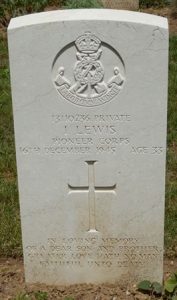
Thomas Joseph McCabe, MiD, Captain, 164915, Royal Inniskilling Fusiliers. Thomas was the son of Thomas Joseph and Magrate McCabe, of Granard, Ireland. He married Elizabeth Jones, of Maes y Bronnydd, Bala, in London in 1940. Thomas was commissioned into the Royal Inniskilling Fusiliers in January 1941, and posted to the 2nd Battalion, Royal Inniskilling Fusiliers. The battalion arrived in Egypt in June 1943 having seen service in Madagascar, India and Persia. On 10 July 1943, the Battalion, as part of the 5th Division, took part in Operation Husky, the invasion of Sicily. They landed at Cassibile, south of Siracuse port and saw heavy fighting over the coming days. Thomas was killed at Tremonte on the slopes of Mount Etna, on 19 July 1943, aged 26. He is buried in Catania War Cemetery, Sicily. Thomas was Mentioned in Despatches on 23 March 1944, after his death.
Eddie Morgan, Tegid St. Eddie cannot presently be identified.
Edward William Morris, Able Seaman, C/JX 195663, Royal Navy. Edward was born at Bala on 10 November 1917, the son of William and Winifred Morris, of Arenig Terrace. He married Margery May Holding, of Ladywood, Birmingham, in 1940. Edward enlisted into the Royal Navy and was posted aboard the Tribal-class destroyer HMS Bedouin. Launched on 21 December 1937, Bedouin served in the Second Battle of Narvik, where she was slightly damaged, and in the 1941 commando raid on the Lofoten islands. On 15 June 1942 she was taking part in Operation Harpoon, a large allied convoy to re-supply Malta, when she was attacked and sunk by the Italian cruisers Raimondo Montecuccoli and Eugenio di Savoia and an SM.79 torpedo bomber, which was shot down by one of the ships AA Gunners just before her torpedo struck Bedouin. Edward was among 28 men killed during the action and sinking. The 24-year-old has no known grave and is commemorated on the Chatham Naval Memorial, Kent.
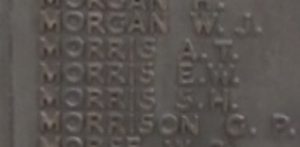
Bingham Everett Peacock, MiD, Lieutenant, Royal Naval Volunteer Reserve. Bingham was born in London on 10 July 1911, the son of Ralph Peacock and Edith Emma Peacock (nee Brignall). The family had lived in Brazil for several years prior to returning to Britain and by 1939 Bingham was lodging at Bronygraig, Bala, where he worked as a Land Agent. He enlisted into the Royal Naval Volunteer Reserve and was posted aboard the Captain-class frigate, HMS Gould. Originally built for the US Navy as USS Lovering in 1943, she was commissioned into service in the Royal Navy as the frigate HMS Gould on 18 September 1943, and served on convoy escort duty in the North Atlantic. On 29 February 1944, Gould was operating as part of the First Escort Group, when the group began a depth-charge attack on the German Submarine U-358. The attack continued into the night and into the morning of 1 March 1944. The U-Boat managed to evade its attackers, and during the afternoon of 1 March 1944 torpedoed and sunk HMS Gould. Bingham was among 122 men killed in the sinking. He has no known grave and is commemorated on the Plymouth Naval Memorial, Devon. Bingham was posthumously Mentioned in Despatches, on 6 June 1944.
David Samuel Phillips, Sergeant, 4199489, King’s Own Scottish Borderers. David was born at Bala on 27 March 1916, the son of Samuel Phillips and Catherine Phillips (nee Jones), of 132, Arenig Street. He married Gladwen Humphreys, of Bala, in 1941. David enlisted into the army and was posted to the 1st Battalion, King’s Own Scottish Borderers. The battalion had been evacuated from Dunkirk on the night of 31 May 1940, and remained in England until landing at Queen Beach, Normandy, on D-Day, 6 June 1944. The battalion took part in the break-out from the Normandy beach-head, and the ensuing drive through Northern France into Belgium and Holland, then from February 1945 took part in Operation Veritable, the Battle of the Reichswald. David was killed on 2 March 1945, aged 28. He is buried in Reichswald Forest War Cemetery, Germany.
David Pritchard, Private, 7933313, Pioneer Corps. David was the son of Edward and Annie Pritchard of Frongoch. He lived at Brynffynnon, Rhosygwaliau.David served with the Pioneer Corps during the war. He survived the conflict, but died in Wrexham on 6 December 1945, aged 35. He is buried in St. Beuno’s Churchyard, Llanycil.
Robert John Roberts, Fusilier, 4199315, Royal Inniskilling Fusiliers. Robert was the son of David and Nell Roberts of Isfryn Parc, Bala. He was married to Eleanor Roberts of Buckley. Robert enlisted into the army and was posted to the 2nd Battalion, Royal Inniskilling FusiliersThe battalion moved to Egypt in June 1943 having seen service in Madagascar, India and Persia. On 10 July 1943, the Battalion, attached to the 5th Division, took part in Operation Husky, the invasion of Sicily. With Sicily captured, the battalion landed in mainland Italy on 3 September, and during the next two weeks advanced 240 miles, taking the town of Isernia, before the advance slowed down. The battalion took part in the heavy fighting which then followed, during the forcing of the Gustav Line, before embarking for Anzio in March 1944, and then continued the advance northwards. Robert was killed during the attack on Gomi on 21 April 1945, aged 28. He is buried in Argenta Gap War Cemetery, Italy.
Morris Rowlands, Fusilier, 4196995, Royal Welch Fusiliers. Morris was the son of Robert and Ellen Hughes Rowlands of Dolwen, Capel Celyn, Bala. He enlisted into the 1st Battalion, Royal Welch Fusiliers, and embarked for France with the battalion, as part of the BEF, in 1940. On 14 May 1940 the battalion first made contact with the invading Germans, on the River Dyle at Ottenburg, north of Wavre, south of Brussels, before being forced to withdraw after the flank of the BEF became exposed. The battalion was forced to march, as no transport was available, and reached the River Escaut on 18 May, where it then held the river line for two days, under constant artillery fire. The battalion was then ordered to withdraw again, reaching Bethune on 24 May, and was ordered to advance westward to capture four bridges over the La Bassée Canal, south of St. Venant. The battalion was caught up in very heavy fighting over the coming days, capturing St. Floris and Robecq, but most of the battalion became surrounded and as a result suffered terrible casualties before the survivors managed to escape and withdraw to Dunkirk. Morris was killed at some time between 25 May and 26 May 1940, aged 21. He is buried in Robecq Communal Cemetery, France.
David Glynn Thomas, Captain, Royal Marines. David was the son of John and Caroline Thomas, of Pontarddulais, and the husband of Elinor Annie Thomas, of Loughor. He had gained his B.A. with Honours prior to becoming a teacher at Bala Grammar School. David served with the Plymouth Division, Royal Marines, attached to the 602 LCM (Landing Craft Mechanised) Flotilla. During the Normandy Landings David was serving aboard the Depot Ship Cap Tourane, which departed from Tilbury before joining the invasion force and arrived off Sword Beach on 7 June. David worked aboard Cap Tourane during the weeks following the invasion. On 25 June 1944, he was in the Commander’s Cabin when it was hit by a bomb, killing David and another man. David was 33 years old, and is buried at Hermanville War Cemetery, France.

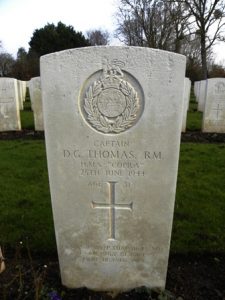
William Williams, Brynygroes. William cannot be positively identified, but he must have worked for Colonel William Johnston, at Brynygroes, prior to the war.